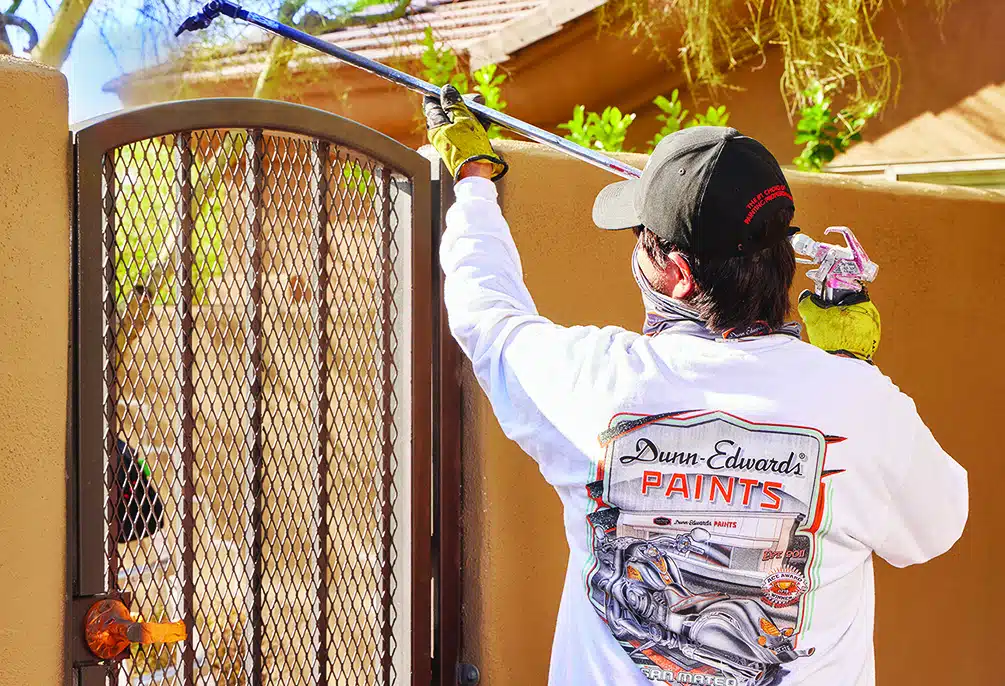Painting Through the Pandemic
01/08/2021 | Dunn Edwards |
How Paint Contractors Can Lower Business Risk While Preparing for the Future

As the country eagerly awaits full distribution of the COVID-19 vaccine, homeowners (who have spent a lot more time inside lately) are increasingly turning to home improvement projects to beautify their spaces. And the prevailing work-from-home model has prompted some businesses to use the extra “empty time” to update their offices.
While a slate full of jobs is the end goal for most painting contractors, there are a few things you need to know in order to protect yourself and your business during the months ahead. Brush up on these three tips to help you paint through the pandemic safely and prosperously.
Tip 1: Have a plan
The US Occupational Safety and Health Administration recommends that all businesses develop an infectious disease preparedness and response plan. While this might sound like overkill, especially if you run a small business, having a plan is always a good idea. It doesn’t need to be anything formal; simply think ahead about a few different scenarios and write down your thoughts on how you might handle them. Here are some questions to consider:
- What is the biggest source of infection risk for yourself, your employees, and your clients? Identifying areas where people might be in closer contact, where access to handwashing facilities is minimal, or where masks are less likely to be worn (e.g., during meal breaks) can help you put practices in place to lower the risk. For example, you could conduct all of your initial client consultations as video calls rather than in-person visits, bring a few bottles of hand sanitizer to distribute throughout each job site, and/or request that employees keep at least a 6-foot distance from others during meal breaks when their masks are removed.
- What will you do if one or more employees become sick? Having a crew contingency plan can help keep your projects on-time and your business running smoothly. Taking this a step further, think about how your employees might react. Do you currently offer paid sick leave? If not, consider it. While it may seem like it would put a financial strain on your business, the strain would be much worse if infected employees came to work because they couldn’t afford to take time off. That could lead to other infections and ultimately, a huge risk for your business. If an employee gets sick, how and when will you inform the other employees and any clients who may have been exposed? Will you require other employees to quarantine or get tested before coming back to work? These are all scenarios that will be easier to handle if you’ve had time to think through them in advance.
- How will your business respond to local lockdowns? While the situation is fluid and different everywhere, planning ahead in case of a lockdown could provide you with extra peace of mind. Have you set aside extra funds in case business is temporarily halted? Do you have a protocol for notifying clients? Will you continue to pay employees during the downtime?
Tip 2: Safety is marketable.
While everyone is processing the impact of the pandemic differently, nobody is against a little extra cleanliness. Letting people know (on your website and through initial interactions) that you are taking additional safety measures during this time can mean the difference between getting a job or not.
According to the CDC, here are some guidelines that you should follow:
- Wear a mask. When you arrive at the job site, make sure to wear a mask that covers your nose and mouth at all times. In addition to protecting you from stray germs, it will protect homeowners and the workers around you as well. Be careful about wearing painting respirators for general coronavirus prevention… while they can provide excellent protection for the wearer, they offer little to no protection for others and that could be a liability for your business. If your respirator has a one-way valve on it, it is likely releasing unfiltered air when you breathe out, so it could allow you to unknowingly spread the virus to a client or employee. When wearing a respirator is mandatory (in working with certain types of paints or other chemicals), try to create a no-respirator-no-entry zone so that others are not exposed to potential risk.
- Clean regularly. Routinely disinfect shared vehicles, equipment, and tools. Encourage employees to wash their hands regularly and stay home if they have any symptoms.
- Keep your distance. Whenever possible, maintain at least six feet (or two arms’ length) of the distance between yourself and others, and encourage your employees to do the same—even when they are wearing masks.
- Ventilate thoroughly. Ventilation has always been important for painters, but now it is even more critical. Whenever possible, open windows and doors to allow fresh air to circulate while working indoors.
- Be vigilant. Know that someone could be a carrier of the virus even if they exhibit no symptoms. We tend to let down our guard with the people we know, but unless they’re isolating 100% of the time outside of work, they could contract the virus and unknowingly spread it. Although it may feel awkward to wear a mask around your most trusted employees or clients, in the end, wearing a mask around them shows that you respect them and value their safety.
For the full list of safety guidelines, visit the CDC and OSHA websites.
Tip 3: We’ll never get “back to normal.” That’s not meant to be pessimistic. Life will definitely get easier, but the pandemic has changed the way people relate and do business… some of it permanently. The more you can accept this and prepare for it, the stronger the position your business will be in the future.
For example, your clients’ expectations for cleanliness and safety have been set higher than before, and that is unlikely to change in the near future. Implementing and maintaining regular hand washing and equipment sanitizing policies is here to stay.
Many people have grown used to the convenience of having video meetings and sending text messages instead of meeting up in person. Even after the pandemic ends, some clients are going to want to maintain contact in this way. If you haven’t already, explore the options available to you for video meetings (many smartphones have a video call feature, and both zoom and Free Conference Call offer free plans).
There has been an increased demand for online ordering, invoicing and payments, appointment setting, and support. Now is the time to expand your offerings in these areas if you haven’t already—because they are here to stay. There are many resources for easy, user-friendly website development (Wix, Weebly, and GoDaddy are a few of the sites with ready-made templates), and many of them offer add-ons for ordering, invoicing appointments, and support.
The bottom line: while it is looking like we’ll rebound from the pandemic sometime this year, it will take some time before we’re fully out of the danger zone. Following these tips can help your business stay profitable now while preparing it for success in the future.














